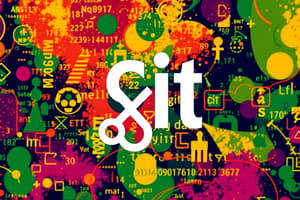Podcast
Questions and Answers
What is the correct pronunciation of Git as per Linus Torvalds?
What is the correct pronunciation of Git as per Linus Torvalds?
- Geee-It
- Gee-Tee
- Ghi-T (correct)
- Jit
Which statement accurately describes the concept of local repositories in Git?
Which statement accurately describes the concept of local repositories in Git?
- Local repositories are accessed via a centralized location.
- Local repositories are not necessary in Git.
- Local repositories contain work done only by the user who owns it. (correct)
- Local repositories are shared among all users.
What does a remote repository serve as in Git?
What does a remote repository serve as in Git?
- A personal backup for each user.
- A centralized location accessible to all users. (correct)
- A repository that cannot be accessed by others.
- A repository that is disconnected from the internet.
Why do users push their new updates to a remote repository in Git?
Why do users push their new updates to a remote repository in Git?
In Git, what is the primary purpose of pulling updates from a remote repository?
In Git, what is the primary purpose of pulling updates from a remote repository?
Why does Git support non-linear development with thousands of parallel branches?
Why does Git support non-linear development with thousands of parallel branches?
Which branching strategy is more suited for teams practicing Continuous Integration and Continuous Deployment (CI/CD)?
Which branching strategy is more suited for teams practicing Continuous Integration and Continuous Deployment (CI/CD)?
What is the primary purpose of Pull Requests (PRs) in Git workflows?
What is the primary purpose of Pull Requests (PRs) in Git workflows?
Which Git best practice is recommended for minimizing the impact of a problematic commit?
Which Git best practice is recommended for minimizing the impact of a problematic commit?
What is the recommended practice for updating a feature branch with the latest changes from the main branch?
What is the recommended practice for updating a feature branch with the latest changes from the main branch?
Which Git best practice is recommended for safekeeping unfinished work?
Which Git best practice is recommended for safekeeping unfinished work?
Which Git best practice aids in understanding the purpose and context of a commit?
Which Git best practice aids in understanding the purpose and context of a commit?
What is the main purpose of creating a feature branch in a Git workflow?
What is the main purpose of creating a feature branch in a Git workflow?
What is the recommended practice for the lifespan of a feature branch?
What is the recommended practice for the lifespan of a feature branch?
What is the recommended practice for working directly on the main branch?
What is the recommended practice for working directly on the main branch?
What is the purpose of a Pull Request (PR) in a Git workflow?
What is the purpose of a Pull Request (PR) in a Git workflow?
What is the recommended practice for merging changes to the main branch?
What is the recommended practice for merging changes to the main branch?
What is the recommended naming convention for feature branches?
What is the recommended naming convention for feature branches?
Flashcards are hidden until you start studying
Study Notes
Git Overview
- Git is the de-facto standard for Version Control Systems (VCS) today.
- Created by Linus Torvalds (Linux creator) in 2005.
- Git supports non-linear development (thousands of parallel branches) and is fully distributed.
Git Basic Concepts
- Git does not need a Centralized Repository to work.
- Every user maintains a local repository of their own.
- Local repositories contain original work, user's own work, and selected work from others.
- Users can commit and update their local repository without interference from others.
Git Repositories
- There are two types of repositories: Local and Remote.
- Local repositories are owned by each user.
- Remote repositories are centralized locations accessible to all users, serving as a single source of truth.
Git Best Practices
- Break down big features into smaller ones and add them one at a time.
- Keep commits atomic, focusing on one part of the feature.
- Commit often, even if the work is not done.
- Pull changes from the origin/main branch before creating a new branch from local/main.
Git General Best Practices
- Push local feature branch commits to Remote often, even if unfinished.
- Use branches to organize work.
- Write good commit messages to help others.
- Select one branching strategy (Git Workflow) and stick with it.
Git Branching
- Create a branch for each feature, avoiding multiple features in a single branch.
- Ideally, only one person should work on one feature branch.
- Feature branches should be short-lived and deleted after merging to the master branch.
- Merge early and often to avoid merge conflicts.
- Keep the master branch clean, only containing production-ready code.
Additional Topics
- Continuous Integration and Continuous Deployment (CI/CD)
- Compare Trunk based development workflow with GitFlow workflow
- Pull Requests (PRs) for collaborating on changes
Studying That Suits You
Use AI to generate personalized quizzes and flashcards to suit your learning preferences.




